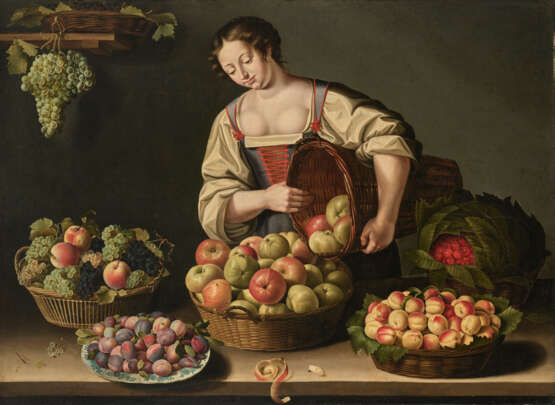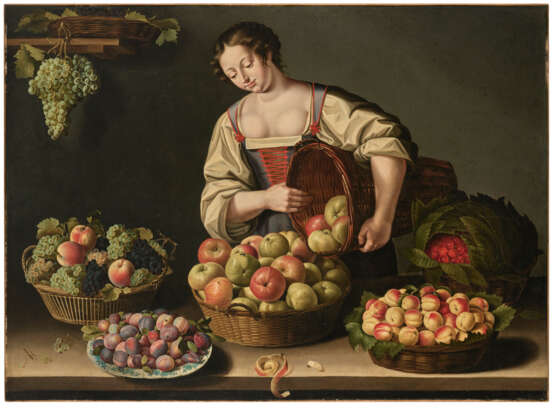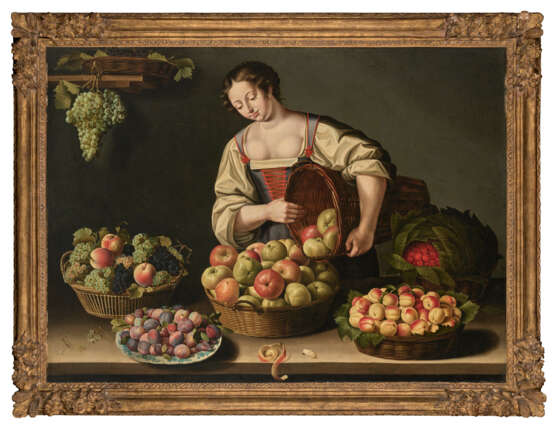LOUYSE MOILLON (PARIS VERS 1610-1696)
11.06.2025 00:00UTC +00:00
Classic
Starting price
500000EUR € 500 000
To bid, go to the website
CHRISTIE'S| Auctioneer | CHRISTIE'S |
|---|---|
| Event location | United Kingdom, London |
| Buyer Premium | see on Website% |
ID 1437197
Lot 21 | LOUYSE MOILLON (PARIS VERS 1610-1696)
Estimate value
€ 500 000 – 700 000
La Marchande de fruits ou Marchande de fruits à son étal
signé et daté 'Louyse . Moillon / 1629.' (en bas, à gauche, sur l'entablement)
huile sur toile
114,8 x 156,5 cm (45 3/16 x 65 1/8 in.)
Provenance
Chez Wildenstein, New York, vers 1959-1960 (selon les catalogues d’exposition de 1959 et de 1960, voir infra).
Collection particulière, New York, entre 1974 et 1986 (selon M. Faré, 1974 et M. Faré et F. Faré, 1986, voir infra).
[Peut-être] Collection particulière, États-Unis (selon D. Alsina, 2009, voir infra).
Collection particulière, France.
Literature
M. Faré, La nature morte en France. Son histoire et son évolution du XVIIe siècle au XXe siècle, Genève, 1962, II, reproduit en noir et blanc fig. 36.
M. Faré, Le grand siècle de la nature morte en France. Le XVIIe siècle, Fribourg, 1974, p. 48, reproduit en couleurs sur la couverture et pp. 48-49.
C. Wright, The French Painters of the Seventeenth Century, Londres, 1985, p. 233.
D. Alsina, 'Louyse Moillon ou la célébration du goût', L’Optimiste (Bulletin de l’étude Tajan), mars 1992, 1, p. 6.
D. Alsina, 'La marchande de fruits par Louyse Moillon', L’Estampille. L’Objet d’Art, juin 1992, 259, pp. 83-84, fiche 259 A, reproduit en couleurs.
M. Faré, F. Faré, 'Louise Moillon, les Girardot, marchands de bois parisiens, et une oeuvre inédite de Louise Moillon', Gazette des Beaux-Arts, septembre 1986, 128e année, VIe période, 108, p. 57 et p. 64, sous la note 33, reproduit en noir et blanc p. 61, fig. 11.
P. Grate, French Paintings I Seventeenth Century, [cat. exp.], Stockholm, 1988, p. 77, sous le n°40 et p. 78, sous la note 1, reproduit en noir et blanc p. 77, ref. 1.
A. Mérot, La peinture française au XVIIe siècle, Paris-Florence, 1994, chap. X, p. 241 et p. 243.
D. Alsina, Louyse Moillon (Paris, vers 1610-1696). La nature morte au Grand Siècle, Dijon, 2009, p. 113, n°3 et p. 326, reproduit en couleurs pp. 112-113, fig. III.
C. Coutin, F. du Mesnil, La vie silencieuse de Louyse Moillon 1610-1696, Paris, 2017, p. 22, p. 41, p. 43 et p. 75, n°3.
Exhibited
Allentown, Allentown Art Museum, Four Centuries of Still Life, 12 décembre 1959-31 janvier 1960, n°68.
Further details
LOUYSE MOILLON (CIRCA 1610-1696), THE FRUIT SELLER, OIL ON CANVAS, SIGNED AND DATED (LOWER LEFT, ON THE LEDGE)
Louyse Moillon (1610-1696) was only nineteen when she painted this majestic picture, dated 1629, which is considered to be only the second signed and dated still life in the history of French painting - the first being that by Jacques Linard (1597-1645), dated 1627, dedicated to Cardinal Richelieu (1585-1642) and now in the Louvre (Paris, inv. DL 1970 12). The immense importance of this work in the history of French painting was highlighted in 1974 when Michel Faré, the celebrated historian of French still life, chose it to adorn the cover of his book Le Grand Siècle de la Nature morte en France, le XVIIe siècle, a work that has yet to be displaced as the defining study on the subject.
This early painting, extraordinarily striking for the ambition of its composition, evidently follows the Dutch and Flemish still-life tradition of the late sixteenth and early seventeenth centuries. We can see the influence of artists such as Jacob van Husldonck (1582-1647), Osias Beerts (d.1623) or, to name another female painter, Clara Peeters (? 1589-after 1657), with whom Moillon shares the high angle view-point and evenly distributed light that bathes their paintings in a warm glow. La Marchande de fruits testifies to the 'absolute sincerity of [its] author', who 'touches us with her scrupulous talent, bent to the truth of the object' (M. Faré, 1974, op. cit., p. 56). Indeed, Moillon offers viewers an abundance of fruit whose realism makes us want to grab an apple, plum or peach from the basket and bite in.
Only eight paintings by the artist featuring figures, almost exclusively women, are known. These works, all of which are imposing in size, depict fruit and vegetables in a context related to trade; they are merchants offering the riches of the countryside to the viewer, who would have been part of the Parisian bourgeoisie. In a mise en abyme of viewer and subject, one of these paintings, À la marchande de fruits, shows a young bourgeois woman buying fruit from a merchant, just as she might have bought a still life from Moillon herself (Fig. 1, Musée du Louvre, Paris, inv. 1955-19).
These subjects are reminiscent of those of Flemish painters such as Joachim Beuckelaer (c.1530-1573) or Pieter Aertsen (1508-1575), and Frans van Snyders (1579-1657) of the next generation, which the young Louyse would have seen in the shop of her father, Nicholas (1555-1619), a portrait painter and art dealer. However, unlike her northern predecessors, Moillon did not include landscapes or architectural elements in the background to lend her works a narrative atmosphere. Instead, she chose to keep the traditional black background of still-lifes. In this way, the artist emphasises the supremacy of the fruit and vegetables, which remain the only true subject of the painting. In this way she lent her fruit and grapes a sort of intense spirituality, which provided lasting inspiration for painters to come.
| Artist: | Louise Moillon (1609 - 1696) |
|---|---|
| Applied technique: | Oil on canvas |
| Art style: | Old Masters |
| Genre: | Genre art, Portrait, Still life |
| Place of origin: | Western Europe, France, Europe |
| Auction house category: | Paintings, Watercolors, Drawings, Paintings |
| Artist: | Louise Moillon (1609 - 1696) |
|---|---|
| Applied technique: | Oil on canvas |
| Art style: | Old Masters |
| Genre: | Genre art, Portrait, Still life |
| Place of origin: | Western Europe, France, Europe |
| Auction house category: | Paintings, Watercolors, Drawings, Paintings |
| Address of auction |
CHRISTIE'S 8 King Street, St. James's SW1Y 6QT London United Kingdom | |
|---|---|---|
| Preview |
| |
| Phone | +44 (0)20 7839 9060 | |
| Buyer Premium | see on Website | |
| Conditions of purchase | Conditions of purchase |






